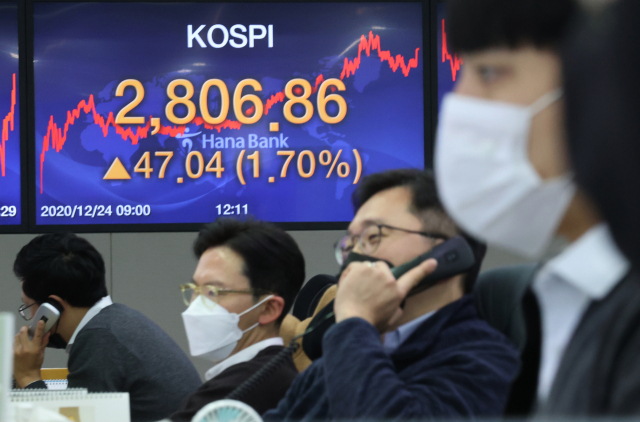‘Concerns about reducing dividends’… Dividend-cheol Bank stock price’slack’
Reporter Hwang Sang-wook [email protected] | 2020-12-25 12:41:41

On the afternoon of the 24th, the KOSPI is displayed on the dealing room at Hana Bank’s headquarters in Euljiro, Jung-gu, Seoul. On this day, KOSPI closed the deal at 2,806.86, up 47.04 points from the previous day. The KOSDAQ index closed at 928.68, up 5.51 points (0.60%) from the previous day. In the Seoul foreign exchange market, the won/dollar exchange rate ended at 1103 won per dollar, down 4.9 won from the previous day’s closing price. Photo provided by Yonhap News
Bank stocks, a leading high dividend stock, showed that during the year-end dividend season, the stock price trend was slower than in previous years due to pressure from the authorities to reduce dividends. According to the Korea Exchange (KRX) on the 25th, the one-month yield of the KRX Bank Index consisting of eight financial holdings and banking stocks was -0.80% as of the 24th.
Considering that the KOSPI and KOSDAQ indices rose 7.85% and 6.34%, respectively, during the same period, the performance of banking stocks was relatively poor. Compared to the KRX Bank Index’s monthly return of 4.84% as of December 24 last year, banking stocks are not working hard during this dividend season.
In general, dividend stocks are often on the rise in the face of a dividend decline due to the rush of buying to receive dividends at the end of the year. In fact, last year’s dividend yield of the KRX Bank index constituents was 4-6%, the highest level among listed companies. By company, Woori Financial Holdings 6.04%, Hana Financial Holdings 5.69%, DGB Financial Holdings 5.76%, IBK 5.68%, JB Financial Holdings 5.46%, BNK Financials 4.70%, KB Financials 4.64%, and Shinhan Financials 4.27%.
However, this year, as the financial authorities recommend reducing dividends to the banking sector, investors’ expectations are lowered, and the popularity of banking stocks is also less than in previous years. The financial authorities are known to have recommended a 20% year-end dividend payout ratio (the ratio of dividends to net income) to banks. This is about 5-7 percentage points lower than the dividend payout ratio of last year’s major financial holding companies. As the economic uncertainty in the aftermath of the Corona 19 crisis is high, the authorities view that banknotes should reduce dividends and expand their loss absorption capacity.
Kim Jae-woo, a researcher at Samsung Securities, said, “Uncertainties related to dividend reductions are a short-term burden to the sentiment of banking stocks. Most investors may see a decrease in profits this year or dividends at financial companies with a low capital ratio. We will consider the difficulty of increasing it significantly.”
There are also observations that it is unlikely that the unusual financial authority’s recommendation to reduce dividends will be reflected in the actual dividend policy for banks.
Seo Young-soo, a researcher at Kiwoom Securities, said, “Unlike the demand for an increase in provisions to improve soundness, which is the authority of the supervisory authority, the dividend policy is a company’s own authority.”
He added, “Even if the dividend payout ratio is lowered, the decline in the dividend yield will not be as large as around 1% due to the response of the bank.” “The negatives related to the dividend reduction were reflected in the stock price to some extent, and the dividend yield is still high at 4~5%.” I looked out.
Reporter Hwang Sang-wook [email protected]
